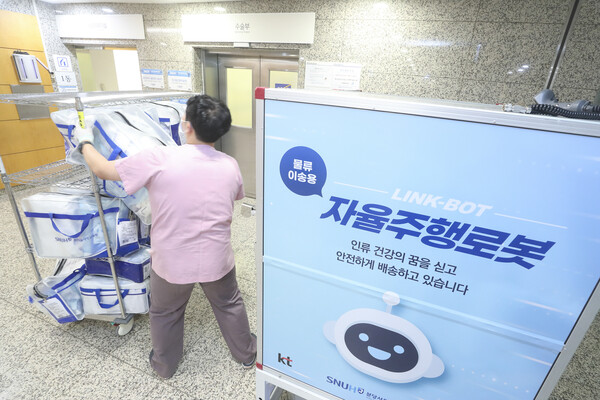In partnership with Korea’s telco giant KT, Seoul National University Bundang Hospital (SNUBH), has harnessed advanced information and communication technology to construct an exceptional smart hospital based on a 5G-specialized network.
While the hospital has a long-term plan to transform itself into a leading smart hospital, this innovative collaboration has already resulted in the implementation of three cutting-edge systems – autonomous mobile robot (AMR), 3D remote education system, and self-driving electric wheelchairs.
The hospital said all these technologies aim to enhance patient safety, optimize hospital operations, and fortify medical capabilities.

Transforming patient care with AMRs
Heavy carts laden with medical supplies are no longer a burden to hospital staff at SNUBH thanks to the introduction of AMRs.
The AMRs now seamlessly transport surgical instruments, medications, linens, and other essential items required for patient care across a distance of approximately 300 meters between the main building and the healthcare innovation park.
Previously, these items were laboriously transported by vehicles and manually pushed by staff, which was burdensome for the hospital staff, especially during peak hours.
The introduction of AMRs during off-peak hours has reduced congestion, minimizing the risk of infections and improving patient safety.
According to the hospital, these smart robots navigate the interconnected hospital facilities, including elevators and automatic doors, without collisions, ensuring a smooth and efficient workflow.
Hospital employees have enthusiastically embraced this technological leap, as it has considerably reduced their physical burden, enhancing their well-being and safety.
"The introduction of robots has significantly strengthened staff safety by eliminating the need to haul heavy carts," a SNUBH staff said.

Empowering physicians, nurses with 5G-enabled 3D remote education
SNUBH has also taken medical education to new heights with its 3D remote education system.
This approach combines smart surgical rooms with virtual medical training, providing young doctors and nurses with an immersive and efficient learning experience.
The hospital's recently established SMART Simulation Center facilitates simulation-based training in real-life hospital environments.
With the integration of 5G-specialized network streaming, the center uses 3D surgical education via virtual reality (VR) glasses, enabling inexperienced doctors and nurses to improve their practical skills.
As trainees immerse themselves in real-time scenarios, they learn to make critical decisions and handle complex situations as physicians and nurses, honing their skills effectively.
Professors can communicate with trainees through a microphone, providing instant feedback, while monitoring the entire educational process through cameras.
The data is also stored and can be reviewed for additional education.
Revolutionizing patient safety with self-driving electric wheelchairs
In collaboration with MD Escort, a company specializing in hospital companion services, SNUBH has launched Wheelie, a self-driving electric wheelchair.
Designed to prioritize safety, Wheelie employs simultaneous localization and mapping (SLAM) technology and light detection and ranging (LiDAR) sensors to navigate hospital corridors to transfer patients autonomously and return to designated waiting areas in unmanned mode.
Also, the Wheelie's auto-hold function ensures the wheelchair does not move backward while a patient is boarding or disembarking, minimizing the risk of falls, a common safety concern in hospital wheelchair usage.
Other features of the wheelchair include its hill start assist and hill descent control features, which maintain steady speeds on inclines and descents, preventing accidents and injuries.
This autonomous wheelchair has the potential to streamline wheelchair management efforts as well.
Leveraging the 5G-specialized network, hospital staff can remotely monitor Wheelies' location, status, and battery levels, facilitating automatic retrieval to storage areas when not in use.
SNUBH President and CEO Song Jung-han expressed immense pride in the hospital's achievements in spearheading the smart hospital era.
"SNUBH continues to progress rapidly in implementing remote healthcare, big data, artificial intelligence, and other cutting-edge technologies to provide patient-centric medical service," Song said. "Supported by the partnership with KT and their consortium, the hospital is steadfast in its commitment to deliver top-tier healthcare services, enriching patients' lives through unparalleled medical capabilities."
Related articles
- SNUBH confirms world's 1st genotype-specific prognosis of female patients with Alport syndrome
- SNUBH, UEMC use AI to improve accuracy, reduce cost of stent procedures
- SNUBH develops tech for real-time diagnosis of sleep apnea in noisy homes
- SNUBH develops technology to measure urination volume using sound
- SNUBH leaps forward as infectious disease specialized hospital on 20th anniversary
- SNUBH develops AI-powered X-ray analysis that can diagnose sleep apnea
- 'Digital devices help boost immunity after influenza vaccination'
- ICU specialist system cuts critical patient mortality by 22%: study
- 'Severe psoriasis can increase risk of uveitis'
- Seoul National University Bundang Hospital unveils cutting-edge online consultation system for patients and guardians
- SNUBH CEO vows to create a leading model in patient care
- SNUBH's hotline system eases anxiety of stroke patients

